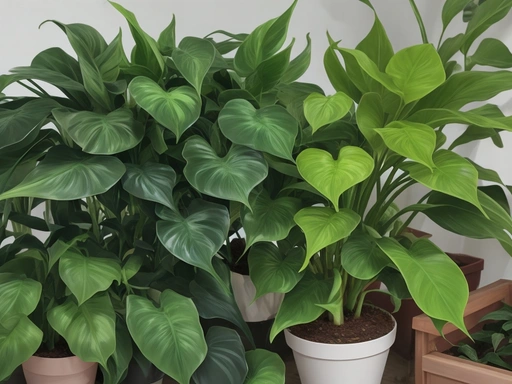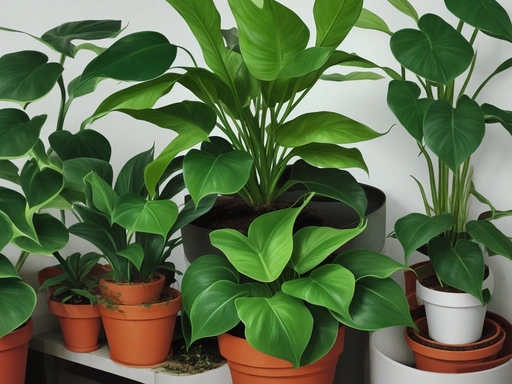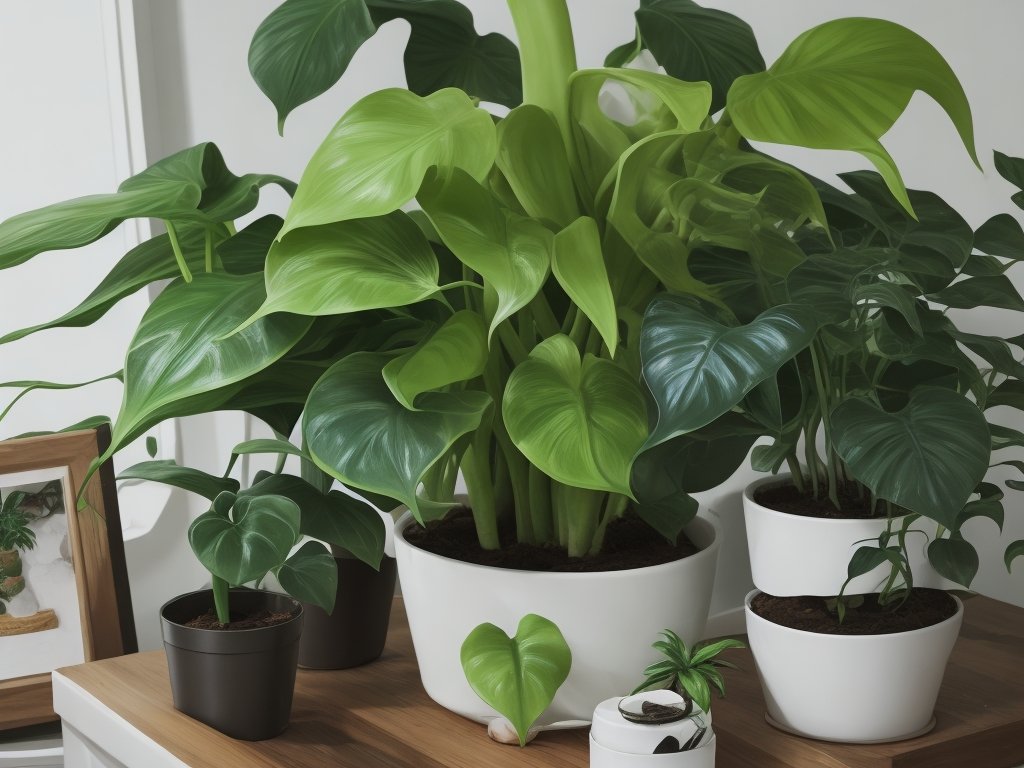Philodendron Seasonal Care Guide: Essential Tips for Thriving Plants!
Key Takeaways:
- Philodendrons thrive in humid environments and prefer indirect sunlight.
- Water philodendrons regularly, but avoid overwatering to prevent root rot.
- Fertilize philodendrons during the growing season to promote healthy growth.
- Prune philodendrons to encourage bushier growth and remove dead or damaged leaves.
Are you a proud parent of a Philodendron? Just like any other living being, these exquisite plants go through seasonal changes, and understanding their needs during each season is key to their thriving growth.
In this comprehensive guide, I will share my expertise on Philodendron care throughout the year, covering everything from light and temperature requirements, watering and humidity guidelines, to dealing with pests and diseases.
Whether it’s spring, summer, fall, or winter, you’ll be armed with the knowledge to keep your Philodendron healthy and happy all year round. Get ready to become a Philodendron whisperer!
| Spring | Summer | Fall | Winter | |
| Temperature | 65-75°F | 70-85°F | 65-75°F | 60-70°F |
| Humidity | 40-50% | 50-60% | 40-50% | 30-40% |
| Light | Indirect bright light | Indirect bright light | Indirect bright light | Indirect bright light |
| Watering | Keep soil evenly moist | Water thoroughly when top inch of soil is dry | Allow soil to dry slightly between waterings | Water sparingly, allowing soil to dry between waterings |
| Fertilization | Use balanced fertilizer every 2-4 weeks | Use balanced fertilizer every 2-4 weeks | Use balanced fertilizer every 4-6 weeks | Do not fertilize |
Understanding Philodendron Seasons
Philodendron seasons impact plant growth and care, so understanding these changes is essential.
Seasonal Changes and Their Impact on Philodendrons
Seasonal changes have a significant impact on Philodendrons. During the spring and summer, these plants thrive in warmer temperatures and longer daylight hours.
They require more frequent watering and benefit from higher humidity levels.
In the fall, as temperatures cool down, Philodendrons adjust by reducing their watering needs and preparing for indoor living. Winter calls for providing optimal light, humidity, and temperature conditions to ensure the plant’s survival.
Understanding these seasonal changes and adapting care accordingly is crucial to the health and growth of Philodendrons.
Spring Care for Philodendrons
Spring is an important time to provide your philodendrons with the care they need to thrive.
Light and Temperature Requirements
Philodendrons thrive in bright, indirect light.
They can tolerate lower light conditions but may not grow as vigorously.
As for temperature, they prefer a warm environment between 65-85°F (18-29°C).
Avoid exposing them to extreme temperature fluctuations and drafts, as it can stress the plant.
Watering and Humidity Guidelines
Water your Philodendron thoroughly, allowing the top inch of soil to dry out between waterings. Avoid overwatering, as it can lead to root rot.
Philodendrons prefer moderate humidity levels, around 50-60%.
You can increase humidity by misting the leaves, placing the plant on a humidity tray, or using a humidifier.
Fertilizing Tips for Spring
In spring, it’s important to fertilize your Philodendrons to promote growth and healthy foliage. Use a balanced liquid fertilizer or slow-release granular fertilizer with a ratio of 20-20-20.
Apply the fertilizer according to the instructions on the packaging, usually every 4-6 weeks.
Make sure to water your plant before fertilizing and avoid overdoing it to prevent fertilizer burn.

Common Spring Pests and Diseases to Watch Out For
During the spring season, Philodendrons may be susceptible to a few common pests and diseases.
Keep an eye out for aphids, mealybugs, and spider mites, which can damage the leaves and hinder growth.
Fungal diseases like root rot and leaf spot may also occur due to increased humidity.
Regularly inspect your plants and take prompt action to address any issues.

Summer Care for Philodendrons
During the summer, Philodendrons require special care to deal with heat and sun exposure, watering needs, pruning, propagation, and pest control.
Dealing with Heat and Sun Exposure
To deal with heat and sun exposure, it’s important to provide your Philodendron with some shade during the hottest part of the day. You can do this by placing it in a location that receives indirect sunlight or by using a sheer curtain or shade cloth to filter the intense sunlight.
Additionally, make sure to keep your Philodendron well-hydrated by watering it regularly, but be careful not to overwater as this can lead to root rot.
Consider misting the leaves to increase humidity and prevent them from drying out. Lastly, keep an eye out for any signs of sunburn, such as yellow or brown patches on the leaves, and adjust the plant’s placement accordingly.

Watering Needs in Summer
During summer, philodendrons require more frequent watering due to increased heat and evaporation. Check the moisture level of the soil regularly, and water when the top inch feels dry.
Remember to water deeply, allowing the water to reach the roots.
Avoid overwatering, as it can lead to root rot. Using well-draining soil and pots with drainage holes can help maintain optimal soil moisture during the hot summer months.
Pruning and Propagation Tips
Pruning and propagation are important aspects of caring for your philodendrons. When it comes to pruning, you can remove dead or yellowing leaves to maintain the plant’s overall health and appearance.
Additionally, you can prune to shape your philodendron or control its size.
For propagation, you have a few options. You can take stem cuttings and place them in water or moist soil to encourage root growth.
Another method is air layering, where you make a small cut in the stem and wrap it in moist moss until roots develop.
Finally, you can divide a mature philodendron plant by separating the root ball into smaller sections and repotting them.
Preventing and Controlling Summer Pests
To prevent and control summer pests on your Philodendrons, it’s important to start with regular inspection. Look for signs of infestation, such as yellowing leaves or webbing.
If you spot pests, isolate the affected plant and treat it with appropriate insecticides or natural remedies.
Additionally, practicing good hygiene, maintaining proper watering habits, and keeping a clean growing environment can help deter pests. Regularly cleaning and wiping down leaves, as well as avoiding over-watering, can go a long way in keeping those pesky critters at bay.
Fall Care for Philodendrons
Fall Care for Philodendrons involves adjusting to colder temperatures, reducing watering frequency, preparing for indoor living, and addressing common fall issues.
Adjusting to Colder Temperatures
To help your philodendron adjust to colder temperatures, gradually decrease the amount of watering to prevent overwatering and root rot.
Place your plant away from drafty areas and protect it from cold drafts.
Providing adequate insulation and maintaining a consistent temperature will help keep your philodendron healthy during colder months.
Reducing Watering Frequency
To reduce watering frequency for your philodendron, make sure the top inch of soil is dry before watering.
Use well-draining soil and pots with drainage holes.
Adjust watering based on the season—water less frequently in fall and winter.
Be mindful not to overwater, as too much moisture can lead to root rot.
Preparing for Indoor Living
To prepare your philodendron for indoor living, start by choosing a suitable spot in your home that receives indirect or filtered sunlight. Avoid placing it in areas with drafts or temperature fluctuations.
Next, make sure to acclimate your plant gradually to the indoor environment by bringing it indoors for a few hours a day initially, then increasing the duration over the course of a week.
Lastly, maintain a consistent watering schedule, keeping the soil moist but not soggy, and monitor the humidity levels to ensure your philodendron thrives in its new indoor home.
Common Fall Issues and How to Address Them
During the fall season, Philodendrons may face some common issues such as overwatering, root rot, and reduced light levels.
To address these problems, it’s important to adjust watering frequency, ensure proper drainage, and provide adequate light.
Additionally, be mindful of temperature fluctuations and pests that can be more active during this time.
Regularly inspect your plants and take necessary action, such as adjusting their location or treating them with appropriate remedies.
Winter Care for Philodendrons
In winter, give your philodendrons enough light and humidity, adjust their watering schedule, maintain optimal temperatures, and prevent common winter diseases.
Providing Adequate Light and Humidity
To provide adequate light for your Philodendron, place it in a spot with bright indirect light. Avoid direct sunlight as it can scorch the leaves.
As for humidity, Philodendrons thrive in humid environments.
You can increase humidity by misting the leaves or using a humidifier nearby. Additionally, grouping your Philodendrons together can create a microclimate with higher humidity.
Adjusting Watering Schedule in Winter
In winter, it’s important to adjust your watering schedule for your Philodendron. Since the plant’s growth slows down during this time, it doesn’t need as much water as it does in the warmer months.
It’s best to let the top inch of the soil dry out before watering, as overwatering can lead to root rot.
Be sure to also reduce the frequency of watering during the winter months. Just keep an eye on your plant and water it when the soil feels dry.
Maintaining Optimal Temperatures
Maintaining optimal temperatures is vital for the health of your philodendron.
Ideally, keep temperatures between 65°F and 85°F (18°C-29°C).
Avoid exposing your plant to extreme temperature fluctuations.
Protect it from drafts, cold air, and sudden temperature changes.
If it gets too chilly, use a heater or move your plant to a warmer location.
Avoid placing it near heating vents or radiators, which can cause the air to become too dry.
Preventing Common Winter Diseases
To prevent common winter diseases in your Philodendrons, there are a few key steps you can take.
Firstly, make sure to provide adequate light and humidity for your plants during the colder months.
Adjust your watering schedule to avoid overwatering, as this can lead to root rot.
Maintaining optimal temperatures is also crucial, as excessively cold or hot conditions can stress your plants.
Finally, keep a close eye on your Philodendrons for any signs of diseases or pests, and take appropriate action to address them promptly.
Year-Round Philodendron Care Tips
To ensure the health and vitality of your philodendron year-round, pay attention to soil requirements and potting techniques, as well as practice proper pruning and training methods. Don’t worry, we’ll also cover troubleshooting common plant problems.
Soil Requirements and Potting Techniques
To ensure proper growth and health of your philodendron, it’s important to choose the right soil and potting techniques.
Use a well-draining potting mix that consists of equal parts peat moss, perlite, and sand.
Avoid compacting the soil too much.
When repotting, choose a container that is slightly larger than the current one to allow for root growth.
Gently loosen the roots when transferring to the new pot.
Remember to water your plant thoroughly after repotting to settle the soil.
Pruning and Training Philodendrons
To keep your Philodendron healthy and looking its best, pruning and training are essential.
Here’s what you need to know:
- Pruning:
- Regularly remove dead or yellowing leaves to improve airflow and prevent the spread of diseases.
- Trim overgrown branches to maintain a compact shape and promote new growth.
- Use clean and sharp pruning tools to make clean cuts.
- Avoid excessive pruning, as it can cause stress to the plant.
- Training:
- Philodendrons have aerial roots that can be guided to climb a trellis, stake, or moss pole.
- Gently attach the aerial roots to the support structure using soft ties or twine.
- Regularly check the ties and adjust them as the plant grows.
- Don’t force the plant to cling to the support; it will naturally find its way.
Troubleshooting Common Plant Problems
If your Philodendron is having issues, here are some common problems and how to fix them:
- Yellowing leaves: This can be caused by overwatering, underwatering, or lack of light. Adjust your watering schedule and ensure your plant is getting enough bright, indirect light.
- Brown, crispy edges on leaves: This is usually a sign of low humidity. Increase humidity levels by misting the leaves or using a humidifier.
- Drooping leaves: This could indicate either overwatering or underwatering. Check the soil moisture and adjust your watering accordingly.
- Pests: Look out for common pests like aphids, mealybugs, and spider mites. Use organic pest control methods or insecticidal soap to remove them.
- Leaf spots or discoloration: This can be caused by fungal or bacterial infections. Trim affected leaves and ensure good air circulation around the plant.
- Leggy growth: If your Philodendron is getting tall and leggy, it may need more light. Move it to a brighter spot or consider pruning to encourage bushier growth.
Remember, each plant is unique, so closely observe your Philodendron and adjust care accordingly. Don’t hesitate to seek further advice if needed.
Frequently Asked Questions
Can I place my Philodendron outdoors during any season?
Yes, you can place your Philodendron outdoors during the appropriate seasons. Philodendrons are tropical plants that thrive in warm temperatures, so they enjoy being outside during the spring and summer.
However, it’s important to avoid exposing them to extreme temperatures, frost, and harsh weather conditions.
Always monitor the weather and bring them indoors if necessary.
How often should I fertilize my Philodendron throughout the year?
Throughout the year, it is best to fertilize your Philodendron every 4-6 weeks. This will provide a steady supply of nutrients without overwhelming the plant.
Use a balanced, water-soluble fertilizer and follow the package instructions for the correct dosage.
Always water your Philodendron before fertilizing to avoid root burn.
What are some signs of pest infestations in Philodendrons?
Some signs of pest infestations in Philodendrons include:
- Yellow or discolored leaves
- Wilting or drooping foliage
- Sticky residue on leaves or surrounding surfaces
- Presence of webs or silk threads
- Visible pests such as aphids, mealybugs, or spider mites.
Do Philodendrons require any special care during flowering season?
During the flowering season, Philodendrons do not require any special care.
However, you can still ensure healthy blooms by providing adequate light, maintaining proper watering levels, and avoiding over-fertilization.
Regularly check for pests and diseases too, and address them promptly if necessary.
Can I propagate my Philodendron in all seasons?
Yes, you can propagate your Philodendron in all seasons! Philodendrons are known to be quite resilient and can be propagated successfully throughout the year.
Whether it’s spring, summer, fall, or winter, you can take cuttings from your Philodendron and propagate them to grow new plants.
Just make sure to follow the proper propagation techniques and provide the necessary care and conditions for successful rooting.
Final Verdict
Understanding the seasonal care needs of philodendrons is essential for their health and vitality throughout the year. Spring requires attention to light, temperature, watering, and fertilizing.
Summer care involves protection from heat and sun, proper watering, and pruning.
Fall care involves adjusting to colder temperatures and reducing watering frequency. Winter care requires adequate light, humidity, and temperature maintenance.
Additionally, year-round care includes proper soil and potting techniques, pruning, and troubleshooting common plant problems.
By following these guidelines, you can ensure that your philodendrons thrive in any season, bringing beauty and greenery to your home or garden.






